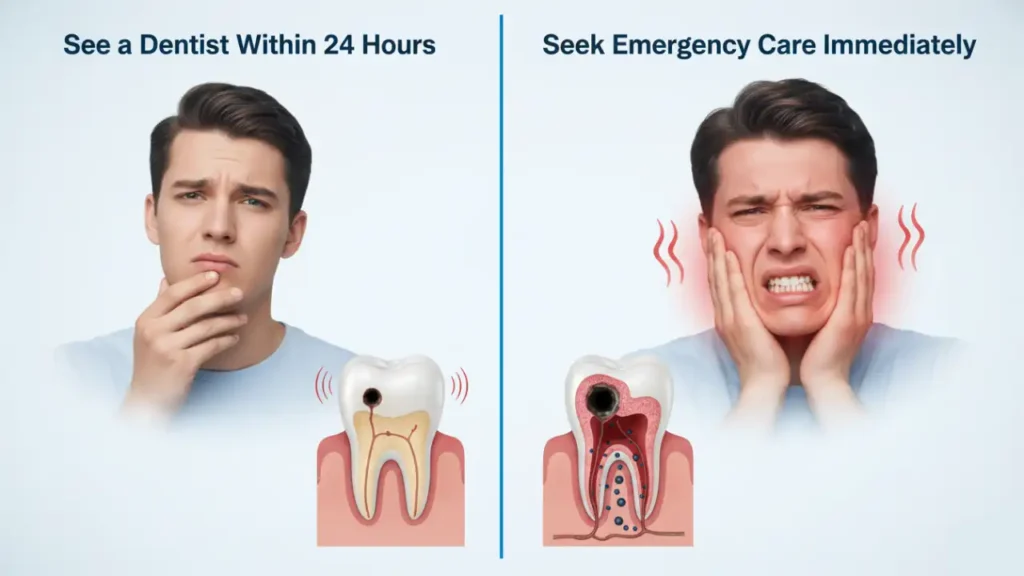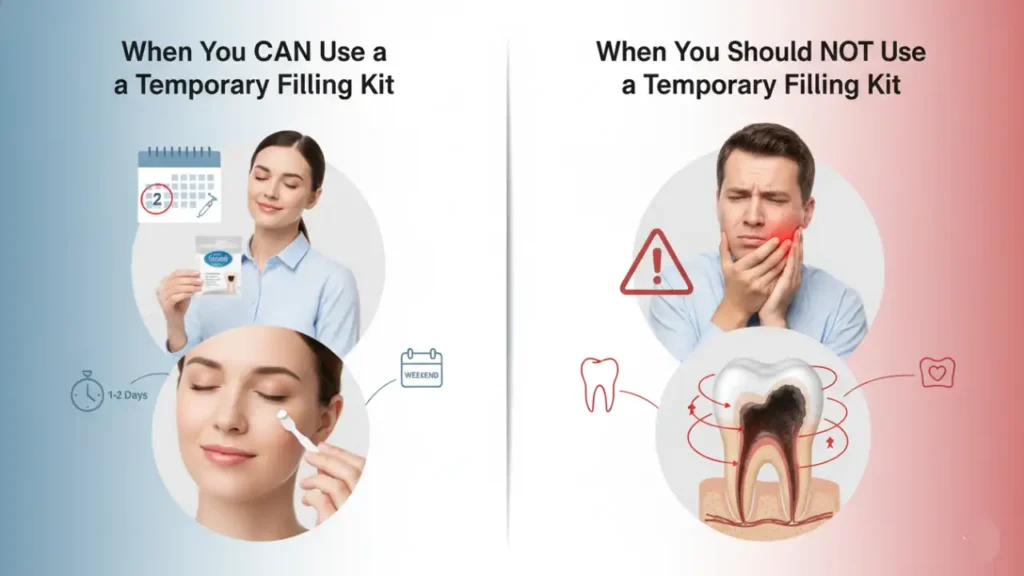Hole in My Tooth: Complete Guide to Treatment, Pain Relief & Home Solutions
It is two in the morning. A sharp, throbbing pain shoots through your mouth, waking you up. Your tongue follows the source instinctively, and there it is: a tiny, surprising hole in your tooth. Panic strikes.
Your mind is racing with questions: “Is this serious? What is the price of this? Do I have an urgent dental appointment?
The Predicament You’re in
If you’re here, chances are you’re dealing with one or more of the following:
- A visible hole in your tooth causes sudden concern
- Sharp, shooting pain when eating, drinking, or even breathing in cold air
- Worry about expensive dental treatments.
- Uncertainty about whether it’s an emergency
- The urgent need for relief before you can reach a dentist
You’re not by yourself. Every year, millions of people go through this exact moment, and many of them make the same mistakes: putting off getting help, turning to risky home cures, or panicking without a clear plan.
The Good News: A cavity or hole in your tooth is highly treatable if you take the right steps right now. In fact, treating cavities early often leads to beautiful smiles. If you’re concerned about your overall dental appearance after treatment, explore smile makeover NYC options to enhance your results.
What Exactly Happens When You Have a Hole in Your Tooth?

A cavity, also referred to as dental caries or a hole in your tooth, is a sign of advanced tooth decay that has actually caused an opening in the structure of your tooth. A hole in your tooth indicates that the protective enamel and the softer dentin layer underneath it have been destroyed by bacteria and acid that have gotten through several layers of tooth structure.
Early-stage decay is not the same as this. Decomposition is often painless and invisible in its early stages. However, the decay has advanced considerably once a hole appears that you can actually see or feel. Your tooth’s inner layers are constantly being attacked by bacteria, food particles, and acids through the hole, which exacerbates the condition every day.
How Does a Hole in Your Tooth Form?
The process of developing a hole in your tooth follows several distinct stages:
Stage 1: Enamel Destruction (Days to Months)
Bacteria colonizing the surface of your tooth are the first step in the formation of a hole in it. The protective enamel layer is gradually eroded by the acids produced by these bacteria. You won’t see anything or experience any pain during this stage. The decay is imperceptible and microscopic.
Stage 2: Dentin Invasion (Weeks to Months)
As acid keeps attacking, it breaks through the enamel and reaches the layer of dentin underneath. At this point, decay speeds up significantly because dentin is softer and more easily broken down than enamel. You may now become sensitive to foods that are hot, cold, or sweet. A noticeable discoloration or dark spot may appear on the tooth.
Stage 3: Visible Hole Formation (Weeks)
The structural damage is now severe enough that you can use your tongue to feel or see a hole in my tooth. Your tooth’s hole turns into a real opening. This is the reason why a lot of people look for answers to questions like “how to fill a hole in my tooth at home” or “what to do if I have a hole in my tooth.”
Stage 4: Pulp Involvement (Days)
The pulp chamber, which contains blood vessels and nerves, will eventually be reached if the hole keeps getting deeper. The kind of excruciating, throbbing pain that makes you say, “I have a hole in my tooth and it hurts,” at two in the morning, is brought on by this. Professional care is urgently needed at this point.
Stage 5: Abscess Formation (Days)
If left untreated, the infection may result in an abscess, or pus-filled pocket, at the tooth’s root. Fever, swelling, and possibly fatal complications result from this.
Why Does a Hole in Your Tooth Hurt So Much?
There is a specific physiological reason why a tooth hole can hurt. Knowing this pain mechanism makes it easier to understand why you need treatment right away.
The mechanism of sensitivity: The dentin layer of your tooth is made up of thousands of microscopic tubules, or tiny channels. External stimuli such as temperature, pressure, and chemicals can directly stimulate the nerves inside your tooth when a hole exposes these tubules. This explains why biting down on hard foods or eating ice cream causes excruciating pain when you have a hole in your tooth.
The Inflammatory Response: Bacteria cause inflammation as they spread farther into your tooth. Pain is made worse by the increased pressure inside the tooth cavity caused by this inflammation. The pain increases with the decay’s proximity to the nerve (pulp).
The Infection Factor: When bacteria reach the nerve chamber, they cause infection and abscess formation. This is one of several signs you need a dental checkup before minor issues become severe infections.
What Are the Early Signs That You Have a Hole in Your Tooth?
Several warning indicators show up before a hole gets big enough to see or feel:
Sensitivity of the teeth. Consuming hot beverages, ice cream, sweet candies, or acidic foods like citrus fruits causes you to feel sharp pain or discomfort. The sensitive dentin layer underneath is made visible by the thinning enamel, which causes this sensitivity.
Observable Discoloration: Your tooth surface develops a dark patch that could be black, brown, or gray. Bacterial colonization and early decay are indicated by this discoloration. This is often noticed weeks before a hole is actually visible.
Discomfort when chewing. Chewing on the afflicted side, particularly when biting down on something hard, causes mild to moderate pain. This is a sign that the decay has spread past the enamel.
Localized Bad Breath: You notice foul odor or bad taste coming from the area around the affected tooth. This is one of the most common gum disease warning signs and treatment indicators that bacteria have colonized your mouth.
Food is Constantly Getting Stuck. Food repeatedly gets trapped between teeth or in a specific spot on the affected tooth, no matter how thoroughly you clean it.
How Can You Feel a Hole in Your Tooth With Your Tongue?
Many people discover their cavity by feeling it. Here’s exactly what happens when you can feel a hole in my tooth with your tongue:
- The Tactile Discovery: With thousands of taste buds and touch receptors, your tongue is incredibly sensitive. You can pick up on even the smallest irregularities when you run your tongue over your teeth. An indentation, depression, or rough pit in the normally smooth tooth surface is what a hole in your tooth feels like. It differs greatly from your molars’ natural cusps and ridges.
- What You’re Actually Feeling: You are feeling the cavity’s edges where the decayed area and the tooth’s intact structure meet. In contrast to the smooth enamel of healthy teeth, the border feels rough or sharp. The pit itself might resemble a tiny crater that just barely fits your tongue.
- The Confirmation: There’s no question that something is amiss once you use my tongue to feel a hole in my tooth. People frequently ignore other warning signs before finally calling the dentist because of this tactile confirmation.
- Safety of Tongue Exploration: Being gentle is crucial, even though using your tongue to explore is safe and won’t harm anything. Avoid using a toothpick or your fingernail to pick at the cavity’s edge, as this could enlarge the hole and cause pain.
What Does a Visible Hole in Your Tooth Look Like?
When you have a hole in my tooth that’s visible:
Appearance Characteristics:
- A small to medium-sized pit or opening in the tooth surface
- Dark coloration, ranging from light brown to black
- Sometimes appearing as a white chalky spot (early decay) or dark crater
- On back molars, it may appear as a small hole on the chewing surface
- On the front teeth, it’s more visible to others and yourself
- On the side surfaces, it might look like an indentation or a chip
Size Variation: The size of the holes varies greatly. Some are big enough to accommodate a tiny pea, while others are pinhole-sized (only 1-2mm). A tiny hole close to the nerve hurts more than a larger hole in the outer layers, so size isn’t always a good indicator of pain intensity.
Progressive Changes: Without treatment, the hole gets bigger and darker over time as the decay spreads farther. A tiny dark patch first develops into a noticeable pit and then, possibly, a sizable cavity.
When Should You Be Concerned About "I Have a Hole in My Tooth and It Hurts"?
While all cavities require professional attention, certain pain patterns indicate you need urgent care:

See a Dentist Within 24 Hours:
- Mild to moderate pain triggered by specific foods or temperature
- Pain that comes and goes
- Visible hole without severe pain
- Sensitivity to pressure when chewing
Seek Emergency Care Immediately:
- Severe, throbbing pain that doesn’t respond to over-the-counter pain relievers
- Constant pain that prevents eating, drinking, or sleeping
- Facial swelling on the side of the painful tooth
- Fever accompanying tooth pain
- Difficulty swallowing or opening your mouth
- Visible pus or drainage from the gum near the tooth
What Causes You to Have a Hole in Your Tooth?
Understanding the causes helps you prevent future cavities after treatment:
Poor Oral Hygiene: The most common cause of holes in teeth is inadequate cleaning. When you don’t brush thoroughly twice daily or fail to floss, plaque accumulates on your teeth. Proper brushing techniques combined with a consistent morning routine for healthy gums can prevent cavity formation entirely.
High Sugar and Acidic Diet: Bacteria in your mouth love sugar and starches. The combination of sugary foods and acidic beverages is devastating. Review the best and worst foods for better teeth to understand which foods accelerate cavity formation and which protect your teeth.
The combination is devastating: bacteria produce acid, and you’re also consuming acid. Frequent snacking, especially grazing on sugary foods throughout the day, is worse than eating all your sugar in one sitting because it constantly feeds cavity-causing bacteria.
Dry Mouth (Xerostomia): Dry Mouth (Xerostomia): Saliva is your mouth’s natural defense against cavities. It washes away food particles, neutralizes acids, and contains antimicrobial compounds. When you produce insufficient saliva (due to medications, autoimmune conditions, or radiation therapy), your cavity risk skyrockets. Learn more about dry mouth causes and natural solutions to protect your teeth.
Genetic and Inherited Factors: Some people are naturally more prone to cavities due to inherited enamel quality, saliva composition, or natural cavity-causing bacteria colonization. If your parents had many cavities, you’re statistically more likely to develop them despite excellent oral hygiene.
Medical Conditions: Diabetes significantly increases cavity risk because high blood sugar increases bacterial growth and reduces saliva production. Discover the important connection between oral health and diabetes to understand how managing your overall health protects your teeth.
Age-Related Factors: Children (ages 2-5) and teenagers develop cavities frequently due to dietary habits, developing motor skills for proper brushing, and the vulnerability of newly erupted teeth. Adults often neglect dental care due to busy schedules. Seniors develop root cavities because receding gums expose the softer root surface to decay.
Smoking and Tobacco Use: Tobacco stains teeth, increases bacterial growth, reduces saliva production, and impairs healing. Smokers have significantly higher cavity rates than non-smokers. Understanding how dental health affects overall health can motivate you to quit smoking.
What to Do When You Have a Hole in Your Tooth?
The first thing to do when you find out you have a hole in your tooth is to remain composed. Professional assistance is necessary when you have a tooth hole that hurts, but it is manageable if you take prompt, wise action.
Immediate Actions (First Hour):
Start by rating your level of pain on a scale of 1 to 10. Your urgency is determined by this. You can make a regular appointment if the rate is 1-3. An urgent appointment is needed today or tomorrow for rates 4-6. A score of 7–10 indicates that you should see a dentist right away.
Manage pain while waiting:
- Take ibuprofen (200-400mg) every 4-6 hours; it’s most effective for dental pain
- Apply an ice pack to your cheek (15 minutes on, 15 minutes off)
- Use saltwater rinse: /2 teaspoon salt in 8 oz warm water, swish 2-3 times daily. This is an effective home remedy supported by the same principles used in professional dental cleaning step by step to manage bacteria and inflammation.
- Apply a topical numbing gel like Orajel directly to the cavity
- Avoid chewing on the affected side
If you can't reach your regular dentist:
- Search for emergency dental clinics
- Contact dental schools for reduced-cost emergency care
- Visit urgent care centers offering dental services
- Go to the hospital ER only if experiencing facial swelling, fever, or difficulty breathing
Foods to absolutely avoid:
- Very hot foods and drinks (coffee, soup)
- Extremely cold foods (ice cream, frozen drinks)
- Hard or crunchy foods (nuts, popcorn, chips)
- Sticky foods (caramel, gum)
- Sugary foods and acidic beverages (soda, juice)
Eat only soft, room-temperature foods like yogurt, bananas, mashed potatoes, and lukewarm soup.
- Severe pain not relieved by pain medication
- Facial or jaw swelling
- Fever above 101°F
- Difficulty swallowing or breathing
- Visible pus or drainage from the tooth
How to Fill a Hole in a Tooth at Home?
Every day, people looking for quick relief search for answers to the question of how to fill a hole in their teeth at home. There are over-the-counter temporary filling kits available, but it’s important to know what they do and don’t do.
Common Temporary Filling Products:
Products with zinc oxide-based putty that form a temporary seal include Temparin, Dentemp OS, and generic store versions, which range in price from $5 to $15. These substances are authorized for short-term oral use and have been used safely for decades.
What these kits accomplish:
- Fill the hole so you can eat without pain
- Reduce sensitivity to temperature and pressure
- Create a temporary barrier against bacteria
- Provide pain relief for 1-4 weeks (usually 2-3 weeks)
- Allow normal functioning while waiting for professional treatment
- Does NOT remove underlying decay
- Does NOT kill cavity-causing bacteria
- Does NOT stop decay progression (it continues underneath)
- Does NOT prevent infection development
- Does NOT provide permanent solution
Below the temporary fill, the following is taking place: The risk of infection rises every day as bacteria keep growing, acid keeps destroying tooth structure, and the hole actually gets bigger and deeper. You’re just covering up the issue while the real one gets worse, not solving it.
Step-by-step application process:
- Prepare thoroughly (this step determines success): Brush gently, floss, rinse thoroughly, then dry the cavity completely. Even slight moisture causes kit failure.
- Prepare material: Roll putty between clean fingers into a small ball (pea-sized or slightly larger). Work quickly before it hardens.
- Insert into cavity: Gently push the putty ball into the hole. Press firmly, but don’t use excessive force. Fill completely and remove excess from the tooth surface.
- Shape and level: Use your finger or the provided tool to smooth the surface until level with the surrounding tooth structure. Remove sharp edges.
- Allow setting: Don’t chew for 1-2 hours. Most kits set initially in 5-10 minutes but need 20 minutes to 2 hours for full hardening. Use your tongue minimally during setting.
- Post-application care: For 24 hours, eat only soft foods on the opposite side. Avoid hard or sticky foods. Avoid brushing directly over the filling. Monitor for deterioration.
- Expected duration: 1-4 weeks typically, with 2-3 weeks being average. Factors reducing duration include chewing on the filled tooth, eating hard foods, and repeated meal exposure. When it fails, the cavity has worsened, and you’re back to square one.
When Should You Use a Temporary Filling Kit?
Temporary filling kits serve a specific purpose in specific situations. Using them wisely prevents problems; misusing them creates false security that delays necessary treatment.

Acceptable situations for using temporary kits:
Within 48 hours, a professional appointment is scheduled. Tomorrow or the day after tomorrow is your dentist appointment. You can relieve your pain and resume your regular eating schedule until your appointment by using a temporary kit tonight.
I have an appointment with the dentist tomorrow, but I can’t get there today. You confirmed a same-day appointment by calling your emergency dentist line. To deal with the pain tonight, use the kit.
It’s Saturday night, you have an appointment on Monday, and your dentist has emergency hours on Monday. The weekend is bridged by the kit.
You live in a remote area with limited access, and although scheduling dental appointments is more difficult there, you have one set for the next one to two weeks. While overcoming scheduling constraints, the kit offers temporary respite.
When absolutely NOT to use temporary kits:
If you can see a dentist within a day, don’t use it. Simply wait. Professional care is far superior to do-it-yourself fixes.
Avoid using it if you have a fever or a swollen face. These suggest an infection that needs to be treated by a professional right away, not with makeshift kits.
Avoid using it if you are in a lot of pain. This suggests extensive decay that may have reached the nerve, necessitating an urgent professional assessment.
If you’re hoping this will take the place of medical care, don’t use it. Many believe they have found the solution by using temporary kits. They haven’t. Pain, not the cavity, is what you’re treating.
Don’t use it if you can’t schedule a professional appointment. If you’re considering using a temporary kit indefinitely because you can’t afford a dentist, talk to your dentist about payment plans. Many patients ask: does insurance cover dental implants in NYC? The same insurance typically covers cavity treatment at 70-80%, making professional care more affordable than you think.
Why You Should See a Dentist Instead of Using DIY Kits
When comparing DIY temporary fillings to professional dental care, the differences are dramatic:
What your dentist does that DIY kits cannot:
- Removes ALL decay (you cannot reach all decay areas yourself)
- Properly assesses cavity depth and whether it’s near the nerve
- Cleans and prepares the tooth correctly
- Uses professional-grade materials designed for durability
- Places temporary or permanent filling that lasts weeks or years
- Prevents infection development before it starts
- Creates a treatment plan addressing your specific situation
What DIY kits cannot do:
- Remove decay (you’re just covering it)
- Assess whether decay reached the nerve
- Prevent bacteria from continuing to multiply beneath the seal
- Provide solutions lasting longer than a few weeks
- Guarantee you won’t develop an abscess
Critical difference: A dentist removes the decay before sealing. You’re just sealing decay. These are fundamentally different approaches with completely different outcomes.
Immediate vs. future pain: The DIY kit provides immediate pain relief, making you feel like you’ve solved the problem. But the underlying decay worsens daily. In 2-4 weeks, when the temporary filling fails, the cavity is significantly larger and deeper. Now you need a crown instead of a simple filling, or worse, a root canal.
Why Professional Treatment Saves Money Long-Term
- Day 1: Filling needed = $150-$300
- Day 7 (if ignored): Still filling-treatable = $150-$300
- Day 30: Decay reaches nerve, root canal needed = $700-$1,500
- Day 60: Tooth dies, extraction needed = $150-$600
- Replacement: Implant or bridge = $3,000-$6,000
- Total cost: $4,000-$8,000
- Day 1: Schedule appointment
- Day 2-3: Professional appointment, get filling = $150-$300
- Total cost: $150-$300
Conclusion
It can be frightening to discover a hole in your tooth, particularly if the pain comes suddenly. In actuality, though, you have more power than you may realize. Quick action, safe pain management, and prompt dental care can mean the difference between a simple filling and a more involved, expensive procedure down the road.
Home cures and temporary solutions can keep you comfortable, but they cannot replace medical attention from a professional. Your chances of saving your tooth, avoiding infection, and lowering expenses increase with the timing of your dental appointment.
Remember, dental problems don’t heal on their own, but with the right steps, they’re completely manageable. If you’ve lost teeth to decay or complications, dental implants in Manhattan top clinics can restore your smile. However, prevention through timely cavity treatment is always superior to replacement.
FAQs
1. What type of crown lasts the longest?
The longest-lasting crowns are those made out of metal. This is the most resistant material from which dental crowns can be made.
2. Which crowns look most natural?
Ceramic and porcelain dental crowns look the most natural of all the other options. They naturally suit the size, color, and shape of human teeth.
3. What is the least expensive type of crown?
The least costly types of dental crowns are resin ones. This is because they aren’t as strong as the other materials. These qualities make it a suitable temporary solution to tooth decay or damage.
4. Can a tooth rot under a crown?
It’s not impossible for a tooth beneath a crown to rot. This happens because the crown is not securely fitted, allowing bacteria or food to get under it.
5. What are crown failure signs?
Some evident signs of crown failure are pain, sensitivity, changes in crown appearance, bite changes, or loose crowns. Any of these signs is concerning and will require a visit to the dentist.
6. What is the downside of Zirconia crowns?
A downside of Zirconia is that it can be difficult to adjust. Additionally, Zirconia crowns are so strong that they may cause the natural teeth they bite down on to wear down.

Dr. Alexander Heifitz (Author)
Dr. Alexander Heifitz is the founder of 65 Broadway Dental in NYC, where he combines advanced dental expertise with a patient-first approach. He specializes in cosmetic and restorative treatments such as dental implants, veneers, Invisalign, and smile makeovers, helping New Yorkers achieve both oral health and confidence.
Booking An Appointment
Looking for a reliable dentist in Downtown NYC? Whether you need a routine cleaning, urgent care, or a full smile transformation — we’ve got you covered. We accept most PPO insurance plans and offer flexible scheduling.
+1 (212) 430-3888
Call for appointment
Walk-ins Welcome / Same-Day Appointments Available

Related Blogs

Top Spot for Dental Implants: NYC Financial District
Discover the best place for dental implants in NYC's Financial District. Expert care, advanced tech, and long-lasting smile solutions all in one trusted clinic.
Read More
Dental Whitening NYC: How to Keep Your Teeth White Longer
Keep your smile bright after whitening! Learn top NYC dentist tips to maintain white teeth, avoid stains, and extend your dental whitening results.
Read More